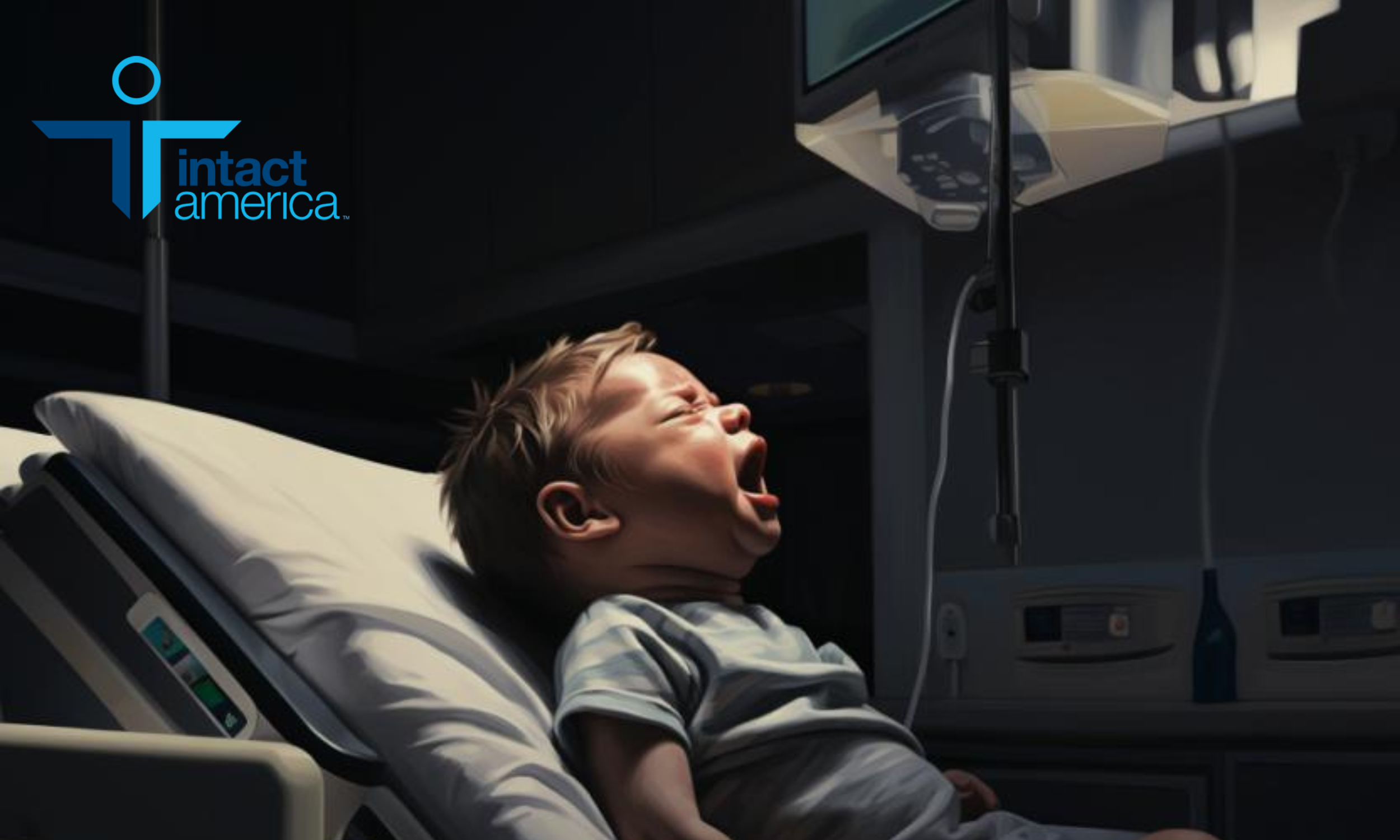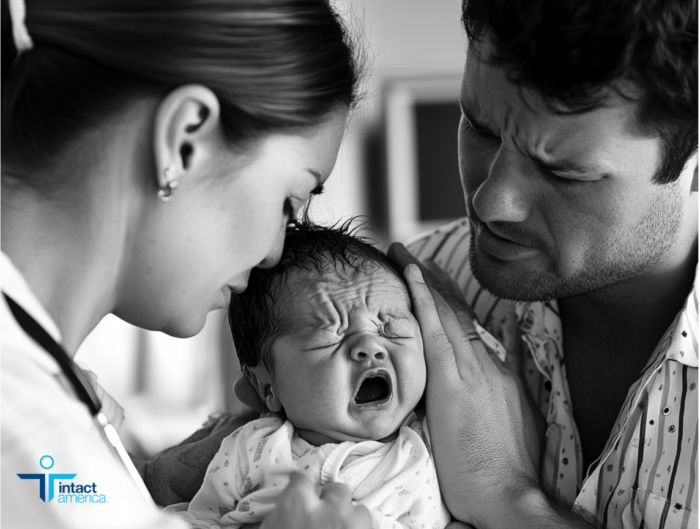
Injuries, trauma, and other complications of infant circumcision in the U.S. are so underreported that even health professionals don’t know the extent of this issue. If health professionals don’t know the considerable risks of this common surgery, how can they convey that information to expectant parents? This article highlights the factors contributing to this significant yet overlooked issue.
Reasons Circumcision Injuries and Traumas Are Underreported
Marilyn Milos notes in her memoir Please Don’t Cut the Baby! (2023, Lucid House Publishing) that the September 2012 American Academy of Pediatrics Task Force on Circumcision report was unable to state that the risks of circumcision outweighed the benefits because “there are no accurate statistics on risks.” When one of the Task Force members was asked how the group could determine whether the benefits outweighed the risks without his information, the individual said they just “felt” the benefits outweighed the risks.
Similarly, Georganne Chapin writes in This Penis Business (2023 Lucid House Publishing):
“I became increasingly incensed at its sheer duplicity. Purporting to review and honestly present the facts, AAP turned a blind eye to serious circumcision injuries and even deaths among American babies. In the section titled Major Complications, the Task Force admits to having excluded “severe and catastrophic injuries,” including ‘glans or penile amputation, the transmission of herpes simplex after mouth-to-penis contact by…Jewish ritual circumcisers…methicillin-resistant staphylococcus aureus infection, urethral cutaneous fistula, glans ischemia, and death, because they are so infrequent as to be reported as case reports.”
This is unacceptable reasoning in 2024, and Intact America challenges the medical and health community’s scientific task forces and grant-supported studies to do better in reporting and determining the risks of circumcision so parents can make an informed decision regarding whether to circumcise their baby boy.
1) Lack of Standardized Reporting Protocols
Fact: A major challenge in accurately documenting circumcision injuries stems from the absence of standardized reporting protocols. There is a notable lack of consistency in documenting or acknowledging complications across medical practices. Without a standardized system in place, many circumcision-related injuries go unrecorded and unnoticed in medical records and statistical analyses.
Remedy: Parents and others who are concerned can undoubtedly ask, in good faith, to be referred to studies or articles on circumcision-related injuries to make an informed decision. Consider it a red flag If your physician cannot provide that information.
2) Cultural and Social Factors
Fact: Cultural norms and social pressures contribute to the underreporting of circumcision injuries. Many societies consider discussing problems associated with circumcision taboo, and acknowledging its complications can be viewed as a challenge to deeply rooted traditions or religious practices. This societal silence frequently hinders individuals from speaking out or seeking help.
Remedy: Break the societal, religious, and generational taboo on speaking about circumcision. Ask questions and expect answers. Then, discuss what you find out.
3) Misdiagnosis or Underdiagnosis
Fact: Misdiagnosis or underdiagnosis adds to the underreporting of circumcision injuries. Often, these injuries may be misinterpreted as other medical conditions, leading to inappropriate or delayed treatment. This issue is compounded by a lack of awareness or specific training among medical professionals regarding the potential complications and proper diagnosis of circumcision-related injuries. The situation is further exacerbated when healthcare providers fail to recognize the signs of these injuries due to insufficient experience or the subtlety of symptoms. Consequently, the true prevalence of circumcision injuries might be severely underreported, as many cases are either not correctly identified or not reported at all. This underdiagnosis affects the patient’s immediate care and limits understanding of the risks associated with the procedure, potentially influencing informed consent and public health policies.
Remedy: Since it is up to expectant parents and others who are interested in fully informing themselves of the issues surrounding circumcision, using Google and other online resources must be part of their due diligence in tracking down potential circumcision-related injuries. The question to ask in every questionable case is:
“Would this child have suffered this injury or trauma if he had not been circumcised?”
4) Reluctance to Seek Medical Help
Fact: Reluctance to seek medical help is another critical factor contributing to the underreporting of circumcision injuries. Parents or guardians, often the primary decision-makers for seeking medical attention for their children, may hesitate to approach healthcare professionals when complications arise post-circumcision. This hesitation can stem from fear of judgment or criticism from medical staff or the broader community, particularly in cultures or communities where circumcision is a widely accepted practice. Additionally, feelings of guilt or responsibility for consenting to the procedure can deter parents from seeking necessary medical intervention. This reluctance is often compounded by a lack of knowledge about the potential complications of circumcision and the ordinary postoperative course, leading to uncertainty about when it is appropriate to seek medical advice. As a result, many circumcision injuries may go unreported and untreated, contributing to an underestimation of the risks and prevalence of complications associated with the procedure.
Remedy: Discuss potential complications with your healthcare provider before making a circumcision decision. If all you are given is reassurance rather than information, consider it a red flag and move on to a more concerned and involved physician.
5) Insufficient Training and Education Among Healthcare Providers
Fact: Insufficient training and education among healthcare providers also contributes to the underreporting of circumcision injuries. Many healthcare practitioners may lack comprehensive training in performing circumcisions and managing post-operative care, leading to unrecognized or improperly managed complications. Without a deep understanding of the potential risks and signs of post-operative issues, healthcare providers might miss early symptoms of complications, resulting in delayed diagnosis and treatment. Additionally, this lack of specialized training can hinder the effective communication of possible risks and outcomes to parents or guardians, impacting their decision-making process. Consequently, injuries or complications arising from circumcisions can go unnoticed or be inadequately addressed, perpetuating the broader issue of underreporting and a diminished understanding of the procedure’s safety profile.
Remedy: Be sure you know who will be doing the circumcision if you decide on the surgery. What is their status and training? Ask how many circumcisions your healthcare provider has performed. Ideally, avoid circumcision entirely.
6) Delayed Onset of Complications
Fact: Some injuries or traumas resulting from circumcision may not become apparent immediately after the procedure, leading to a decreased likelihood of being linked to the circumcision itself. This delay can range from days to weeks, and sometimes even longer. Consequently, healthcare providers, parents, or guardians may not readily connect them back to the circumcision when symptoms eventually appear. This lack of immediate association can lead to a failure to report these issues as circumcision-related complications.
Furthermore, this delayed onset can lead to complications being misattributed to other causes or conditions, further obscuring the connection to the original procedure. As a result, the incidence of circumcision-related injuries might be significantly underreported, as the delayed nature of some complications masks their true origin and frequency. This delay in the manifestation of symptoms complicates the monitoring and evaluation of circumcision safety and risk profiles.
Remedy: No matter how much time has passed between a circumcision and a physical or mental complication of one’s own body or your child’s, remember to list circumcision as a surgery when you are asked by health personnel for a history.
7) Impact of Minor Injuries Being Overlooked
Fact: Often, injuries that initially seem minor may not be reported or are disregarded by healthcare providers or parents as everyday post-operative occurrences. This disregard can result from a lack of understanding of the potential long-term consequences of these “minor” complications. For example, small cuts, excessive bleeding, or slight infections might appear inconsequential initially but can lead to more severe health issues if not adequately addressed. Such complications can have lasting impacts on the child’s health and well-being. The dismissal of these minor injuries not only prevents appropriate and timely medical intervention but also distorts the perceived safety and risk profile of circumcision. As a result, the full spectrum of risks associated with the procedure remains under-documented, leading to a gap in the collective medical understanding and public awareness of circumcision complications.
Remedy: Report all variations in what is listed as normal in your post-operative instructions regarding circumcision or any symptoms, even seemingly unrelated, that make you uncomfortable or don’t understand.
Final Notes About Why Circumcision Injuries and Traumas Are Underreported
The pervasive underreporting of circumcision injuries and traumas is a critical issue. Factors such as misdiagnosis, reluctance to seek medical attention, lack of adequate training among healthcare providers, delayed onset of complications, and trivialization of minor injuries exacerbate this problem. These factors contribute to a concerning lack of understanding about the full range of risks inherent in circumcision.
Raising awareness among healthcare providers and parents about the potential complications of circumcision and questioning the necessity of this procedure is imperative. Additionally, creating an environment that encourages open discussion and eliminates the stigma around seeking medical help for circumcision complications is crucial. Acknowledging even minor injuries as significant and understanding their potential long-term consequences is essential to advocating for the safety and well-being of infants and children.
Confronting these issues requires a unified effort from the medical community, parents, and caregivers to foster a more comprehensive and truthful understanding of the risks associated with circumcision. As part of this effort, we must question the routine practice of circumcision and consider the rights of the child to bodily integrity. Let us join together to advocate for informed choices and to put an end to routine infant circumcision.








No Comments